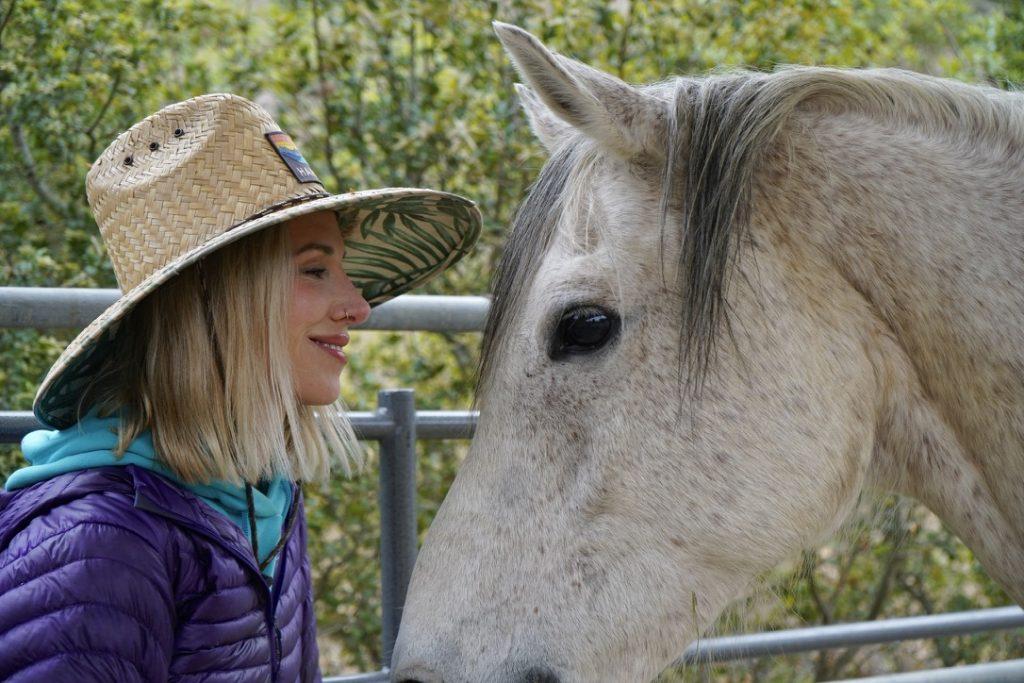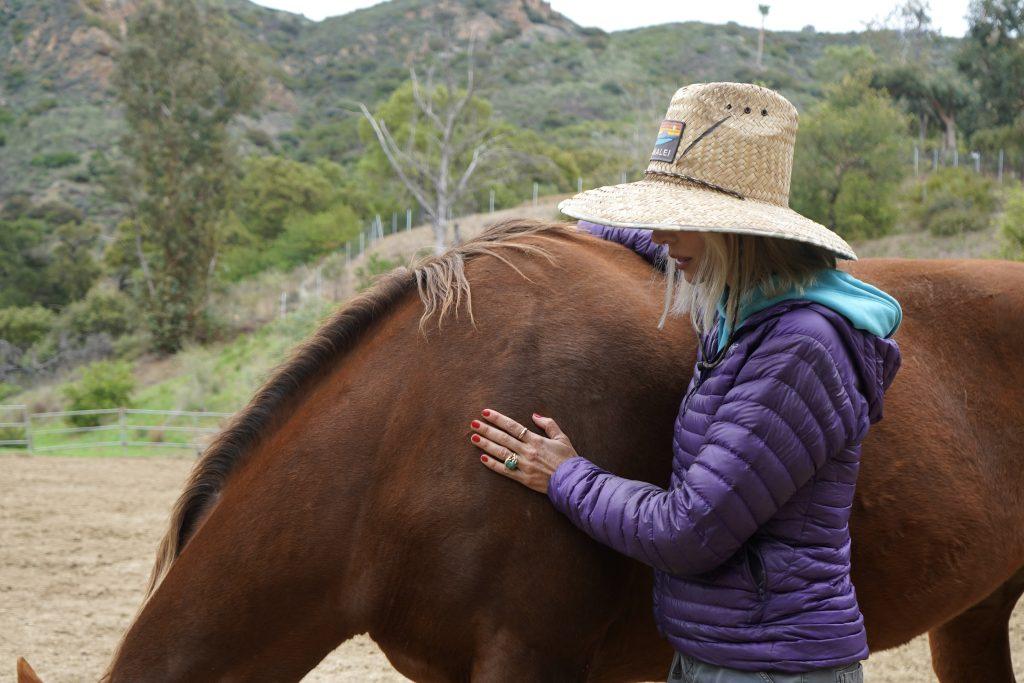
One of the many compelling moments Rose Mary Riggs said she has witnessed in her equine therapy practice was a military veteran facing the grief of losing his 3 year-old son in a tragedy.
The loss had caused his family so much pain, and ruptured the relationship with his family because he felt so much guilt.
During a large group session at Riggs’ Shakti Ranch in Malibu, the group held space for the veteran as he interacted with the horse.
During Riggs’ facilitation, by talking him through where to go, what to do and what he was feeling, there was a sudden pivotal moment where he realized “he did everything that he humanly could [for his son] and it just was not in his control.”
He was finally able to forgive himself after years of self-doubt and a sense of responsibility around his son’s passing.
“To be able to shift back into what is most true, that the love was true, the connection was true, instead of being consumed by guilt, is everything,” Riggs said.
Riggs began working with horses at a young age and said she always felt a deep connection to them. In her 20s and 30s, she studied various forms of therapy before she came across equine-assisted therapy, which caught her attention as a possible high-impact practice.
This is when she decided to start Shakti Ranch in Malibu, a place for a unique form of therapy to help people heal through a connection with themselves and the horses. Through her training and work with trauma survivors, particularly military veterans, she recognizes horses as powerful guides in healing.
Who Benefits from Equine Therapy?
Riggs works with a number of different clients at her ranch, ranging from veterans, abuse survivors, individuals diagnosed with PTSD, anxiety and depression and those facing major life transitions. She even works with younger clients, specifically children with special needs.
During an equine-assisted therapy session, the facilitator guides the client into an observation of the herd, environment and self, Riggs said. Through this connection, the client begins to access more of the right hemisphere of their brain, where studies show humans have an increased capacity for intuition and emotional intelligence. Later, the facilitator invites the client to move toward the horse they are feeling curious about, eventually making a hands-on connection with the horse while they continue to observe themselves.
As an equine-assisted therapist, Riggs’ role is to look to the horses as a guide for how to navigate the session with her client. Much of this is based on observation of the horse and client’s behavior during the hands-on connection.
Horses don’t think in stories like humans do, which helps people to break free from mental loops. It allows clients to have sudden moments of clarity, almost like an “aha” moment, said Emma Barnosky, equine-assisted learning facilitator.
“Horses help us hone the ability to discern and to really take in information in a more neutral, receptive, curious way,” Riggs said.

Moriah Staph, an associate marriage and family therapist and equine facilitator, said equine therapy has a great impact and is very healing for anyone who is interested, whether a person has experienced trauma, is trying to regulate their nervous system or is just looking for a deeper connection with themselves.
“Equine therapy is the fastest, most powerful form of therapy,” Barnosky said.
Structure of Sessions
Not only is the horse’s presence powerful to those taking the session, but also to those facilitating it, Staph said.
“Every time I’m there, you realize how magical it is too, in ways that you couldn’t fully explain,” Staph said.
Barnosky serves as a translator between the horse’s behavior and a client’s emotional state. The sessions are usually 60 minutes but are flexible, depending upon the client’s needs at the time.
Some clients have structured exercises to foster connection with the horse. Others co-create their session with the horse and let the interaction be natural and see where it goes. Some only focus on nervous system regulation, where just being near the horse can bring a sense of grounding.
Riggs said she has many exercises that she has created over the years to facilitate a therapeutic experience for clients, but the hands-on connection exercise is the foundation that she uses most.
“I really think of the horses as the therapeutic engine,” Barnosky said. “I’m just there to facilitate and translate.”
The Role of Horses in Therapy and The Science Behind it
Horses help individuals process emotions in a non verbal way. They help people become aware of emotions they might be suppressing, Staph said.
“They act as these beautiful mirrors for us to kind of see what’s going on within and under the surface of ourselves that we’re not always aware of,” Staph said.
Horses don’t judge, but they reflect exactly what’s going on inside someone. Their presence helps people regulate emotions and stress through body language, Riggs said.
“As humans come within even 20 feet of a horse, the horses will begin to mirror back to you your internal state,” Riggs said.
Junior Delfy Balderrama-Carrillo began horseback riding at age 5. Even though she hasn’t attended equine-assisted therapy, she said her relationship with the horse on the ground is extremely important for building trust. A lack of relationship affects performance and connection during riding, since the horses can sense emotions and energy so well.
“There will be times when I’m having a really rough day, and I go into the stall with my horse, and we just chill,” Balderrama-Carrillo said. “It creates this very peaceful environment.”
Balderrama-Carrillo has been riding a different horse now that she is in Malibu, but at home in Culiacan, Mexico, there is one specific horse she has been riding since she was 18, and she sees a big difference between the two.
“If there’s no relationship on ground and outside of the ring, it makes a very big difference,” Balderrama-Carrillo said.
The No. 1 benefit to equine therapy is nervous system regulation, Riggs said. Regulating one’s nervous system can reduce stress, lessen anxiety and increase a sense of presence, leading people to be more receptive and be able to take on others’ perspectives. These emotional qualities are what set people up for a high level of happiness and fulfillment in connections and relationships.
“Being in nature and being around them, it really just kind of calms you down and puts things in perspective,” Staph said.
More specifically, horses have a unique ability to regulate human nervous systems due to their own physiological responses. Since a horse is eight to 10 times the weight and size of a human, their electromagnetic field is much stronger. Their large electromagnetic field influences a human’s heart rate variability, which in turn calms the nervous system.
A Horses’ way of being is inherently calm, present and highly receptive, which is a nervous system state similar to the parasympathetic nervous system, which triggers the “rest and digest” state. This leads to lower stress levels, Riggs said.
Something as simple as hugging a horse and a few moments of silence can change one’s mood, Balderrama-Carrillo said.
Something called heart rate synchronization can also occur during a session. Over time, a human’s heartbeat syncs with a horse’s, which slows down anxiety-driven states. This is a similar effect to when horses within the same herd also synchronize their heartbeats, creating a natural calming effect for them all, Barnosky said.
“They’re very perceptive to the way that you’re feeling,” Balderrama-Carrillo said.
_________________________________
Follow Currents Magazine on X: @PeppCurrents and Instagram: @currentsmagazine
Contact Anežka Lišková via Instagram @anezka.liskova or email: anezka.liskova@pepperdine.edu

